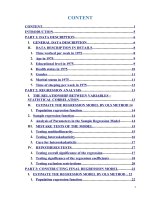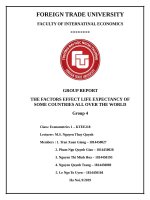tiểu luận kinh tế lượng tài chính FACTORS AFFECTING THE CRUDE BIRTH RATE IN DEVELOPING COUNTRIES IN 2017
Bạn đang xem bản rút gọn của tài liệu. Xem và tải ngay bản đầy đủ của tài liệu tại đây (304.71 KB, 38 trang )
FOREIGN TRADE UNIVERSITY
FALCUTY OF BANKING AND FINACE
====000====
ECONOMETRICS REPORT
FACTORS AFFECTING THE CRUDE BIRTH RATE IN
DEVELOPING COUNTRIES IN 2017
CLASS ID: KTEE310 (1-1920).1_LT
Members:
1. Nguyen Ngoc Diep – 1813340013
2. Dang Hong Nhung – 1813340048
3. Dang Thu Phuong – 1813340050
4. Pham Anh Thu – 1813340063
Lecturer: Dr. Nguyen Thuy Quynh
Hanoi, December 2019
TABLE OF CONTENT
ABSTRACT...........................................................................................................1
INTRODUCTION.................................................................................................2
SECTION 1. OVERVIEW OF THE TOPIC......................................................4
1. The definition of Crude birth rate................................................................4
2. The crude birth rate in developing countries.................................................4
2.1 Developing countries..................................................................................4
2.2 The crude birth rate in developing countries.............................................4
3. Economic theories...........................................................................................5
3.1 The effect of GDP per capita on crude birth rate.......................................5
3.2 The effect of female labor force participation rate on the crude birth rate6
3.3 The effect of infant mortality rate on crude birth rate................................6
4. Related published researches.........................................................................7
SECTION 2: MODEL SPECIFICATION..........................................................8
2.1 Methodology in the study..............................................................................8
2.1.1 Method to derive the model.....................................................................8
2.1.2 Method to collect and analyze data.........................................................8
2.2 Theoretical model specification....................................................................8
2.2.1 Specification of the model........................................................................8
2.2.2. Explanation of the variables.................................................................10
2.2.3. Description of the data.........................................................................10
SECTION 3. ESTIMATED MODEL AND STATISTICAL............................12
INFERENCE.......................................................................................................12
3.1 Estimated Model..........................................................................................12
3.1.1 Estimation result....................................................................................12
3.1.2 The sample regression model.................................................................12
3.1.3 The coefficient of determination............................................................12
3.1.4 Meanings of estimated coefficients........................................................13
3.1.5 Other results analysis............................................................................13
3.2 Hypothesis Testing......................................................................................14
3.2.1 Testing the significance of an individual regression coefficient ...........14
3.2.2 Testing the significance of the model.....................................................16
3.2.3 Test the assumptions of the classical model...........................................17
3.3 Recommendation.......................................................................................19
CONCLUSION....................................................................................................21
REFERENCES....................................................................................................22
APPENDIX..........................................................................................................23
1. The dataset of 132 developing countries in 2017.........................................23
2. Command list used when analyzing dataset by Stata ver.12.......................29
3. The Stata estimation outputs........................................................................29
INDIVIDUAL ASSESSMENT...........................................................................33
ABSTRACT
Crude birth rate is an important determinant of population growth (or
decline) - a crucial factor in the process of social and economic development.
Developing countries face an environment that is less favorable for economic
growth than did the developed countries of the past and overpopulation is the
main cause of it.
After discussing our group would love to take the topic “Factors affecting
the crude birth rate in developing countries” to gain a deeper insight in that
important socioeconomic factors. Our report researched about the determinants of
crude birth rate from 132 currently developing countries using the methods of
cross-sectional data analysis. In which you will know now what has been leaving
big impact to the rate throughout the decades.
Due to the limited of data
resources, we can only pick up a few prominent factors from those countries
including GDP per capita, mortality rate (infant - per 1,000 live births), labor
force participation rate (female - % of female population ages 15+).
As a result of this study, if GDP per capita get higher and higher in the developing
countries, the number of children born per woman get lower. Infant mortality rate
may decrease due to poverty reduction as related with high income. In addition,
crude birth may decrease due to increase in female labor force participation rate.
In the end, we can figure the solution for this matter to minimize the rate
in order to help developing countries.
1
INTRODUCTION
First of all, we want to express our sincere thanks to our lecturer – Dr.
Nguyen Thuy Quynh to have been doing her best to teach us Econometrics and
providing us great guide in order to finish this report. This has been such an
amazing yet challenging journey for us to finish this research of Econometrics
which is contain truthful data with proof of information source as well as doing
the calculation by ourselves.
Econometrics
is
the
quantitative
application
of
statistical
and
mathematical models using data to develop theories or test existing hypothesis in
economics and to forecast future trends from historical data. It subjects real-world
data to statistical trials and then compares and contrasts the results against the
theory or theories being tested.
Overpopulation is a hardship that every developing countries has to face,
specially developing will struggle more to overcome it. Keeping the crude birth
rate at an acceptable rate is important so in the first step, we have to know which
the determinants are. Which is the reason why our group decide to choose this
topic, not only to understand more about the crude birth rate but also to reach
some effective solutions to minimize the rate, to help the developing countries
strengthen their economy.
In the report, we will use the econometric model to find out the
relationship between GDP per capita, mortality rate (infant - per 1,000 live
births), labor force participation rate (female - % of female population ages 15+)
by using collected data from World Bank, statistical website from government
and others sources, whether they have positive or negative relationship, how
significant are the impact. And looking through the process, we may have some
solutions to the high crude birth rate in developing countries.
2
The report contains the following contents:
Abstract
Introduction
Section I: Overview of the topic (Review of economic theories and
statement of research hypotheses)
Section II: Model Specification
Section III: Estimated model and statistical
Inferences
Conclusion
References
Once again, we sincerely thank our instructor – Dr. Nguyen Thuy Quynh
for supporting us to implement this report. During the progress of the report,
despite all of the efforts, we certainly cannot avoid the errors, we look forward to
your comments so that our team can improve this report.
3
SECTION 1. OVERVIEW OF THE TOPIC
1. The definition of Crude birth rate
The crude birth rate is the number of live births occurring among the
population of a given geographical area during a given year, per 1,000 mid-year
total population of the given geographical area during the same year.
The crude birth rate is called "crude" because it does not take into account
age or sex differences among the population. In our hypothetical country, the rate
is 15 births for every 1,000 people, but the likelihood is that around 500 of those
1,000 people are men, and of the 500 who are women, only a certain percentage
are capable of giving birth in a given year.
(Number of resident live births / Number of total population) x 1,000
Total Resident Live Births
Total Population
X 1,000
=
Total Population
2. The crude birth rate in developing countries
2.1 Developing countries
A developing country (or a low and middle income country (LMIC), less
developed
country,
less
economically
developed
country
(LEDC),
or
underdeveloped country) is a country with a less developed industrial base and a
low Human Development Index (HDI) relative to other countries.1
2.2 The crude birth rate in developing countries
In general, birth rates in countries with low or medium levels of
development are quite high due to many reasons from both social and economic
1 O'Sullivan A, Sheffrin SM (2003). Economics: Principles in Action. Upper Saddle River, New Jersey 07458:
Pearson Prentice Hall.
4
aspects. The birth rates in LEDCs are high whilst most MEDCs have a low birth
rate due to their economic development. The W.F.S estimate that only
270,000,000 of the 900,000,000 couples in the world are using modern
contraception and so it is understandable why there is such a rapid growth in the
world’s population.
3. Economic theories
We would like to make some analysis in order to have a better
understanding about which determinants affect the crude birth rate of a
developing countries. According to some other related researches, some factors
that have significant effect on the crude birth rate was GDP per capita, Female
labor force participation rate and Infant mortality rate.
3.1 The effect of GDP per capita on crude birth rate
GDP per capita shows how much economic production value can be
attributed to each individual citizen. Alternatively, this translates to a measure of
national wealth since GDP market value per person also readily serves as a
prosperity measure1. Therefore, higher GDP per brought in its wake higher
standards of living, better food, adequate clothing and shelter, as also protection
from the natural disasters of drought and famine. Income should be a remarkable
value of health is more reasonable in less developed countries than in rich ones. If
many people do not have enough money to buy sufficient food, especially
children seldom suffer from a poor diet, and parents do not provide to feed their
children, there is a dramatic decrease in crude birth rate (Deaton, 2003).
In fact, the last two centuries have witnessed a fall in the death rate and
the consequent growth of population in today’s economically advanced countries.
The Crude birth rate also fell. According to search conducted in South Africa, this
1 According to Invetopedia.com
5
work finds evidence of grand effect of income on health outcomes which directly
affect the Crude birth rate due to lower risk in giving birth (Case, 2004: 295).
While people in less developed countries do not benefit from adequate
health cares, people in developed countries take suitable health cares. This
differences leads to a fact that children in LECD are seen as a part of labor force
which then contribute to high rate of birth.
3.2 The effect of female labor force participation rate on the crude birth rate
There is a tight relationship between female labor force participation rate
on the crude birth rate. The higher rate of female in labor force shows that they
spend more time for career, which may reduce time for family. They also aware
more about the higher standard living when they have just 1 or 2 children. It’s
been proving by the fact now happening in developed countries such as Western
countries. Furthermore, lower rates of fertility can, in principle, free up a
significant amount of women’s time, hence allowing them to enter the labor force
more easily. And this is of course independent of health complications – having
children is very time consuming even when enjoying perfect health.
3.3 The effect of infant mortality rate on crude birth rate
Infant mortality is the death of young children under the age of 1. This
death toll is measured by the infant mortality rate (IMR), which is the number of
deaths of children under one year of age per 1000 live births. The under-five
mortality rate, which is referred to as the child mortality rate, is also an important
statistic, considering the infant mortality rate focuses only on children under one
year of age1. Owing to the weak healthcare facilities in those countries and low
education attainment in some area, infant deaths are quite high. Since mortality
rates are usually high, parents make up for this by increasing the number of
children they have.
1 "Under-Five Mortality". UNICEF. Retrieved 2017-03-07
6
4. Related published researches
There is strong evidence of a causal link between fertility (having
children) and labor market outcomes (participation, employment, wages, etc.). In
a recent study Lundborg, Plug and Rasmussen (2017) show that women who are
successfully treated by IVF (in vitro fertilization) in Denmark earn persistently
less because of having children. They explain the decline in annual earnings by
women working less when children are young and getting paid less when children
are older.
Goldin and Katz (2002) shows that there is evidence that women’s control
over their own fertility is linked to career investments and subsequent changes in
labor market outcomes There are many other studies that find similar effects on
female labor supply when there are exogenous shocks to fertility.
In 2015, Zareena Ali, Talib Hussain, Fawad Azam’s study “Empirical
Relationship of Crude birth rate, Female Literacy Rate and GDP Per Capita with
Child Mortality Rate in Pakistan” shows that decrease in Crude birth rate means
child mortality rate will be also low. It is clear that Crude birth rate is high it is
difficult for parent and government to provide efficient health facilities children
as compare to developed nations and vice versa.
Ghazi M. Farooq, in his book ‘Fertility in Developing Countries (1985)’,
takes evidence from the works of eminent economists like Frederiksen, (1969)
and Zachariah(1973) to conclude the following, “a reduction in mortality is
considered a necessary, although insufficient condition for reduction in Fertility” .
He also mentions that, according to WHO report of 1974, countries with high
rates of mortality have high Crude birth rates as well. Empirical analysis on the
relationship between mortality and Crude birth rates has gained momentum in
recent years.
7
8
SECTION 2: MODEL SPECIFICATION
2.1 Methodology in the study
2.1.1 Method to derive the model
We use ordinary least squares method (OLS) for multiple regression
analysis. The method of ordinary least squares is attributed to Carl Friedrich
Gauss, a German mathematician. Under certain assumptions, the method of least
squares has some very attractive statistical properties that have made it one of the
most powerful and popular methods of regression analysis, for it has best linear
unbiased estimator.
2.1.2 Method to collect and analyze data
2.1.2.1. Collect the data
The dataset is cross-sectional data of Crude birth rate, GDP Per Capita,
Female labor force participation rate and Infant mortality rate for the year 2017 in
132 developing countries1 (listed in the appendix). The data is secondary and
collected from World Data Bank – a high precision data source.
2.1.2.2. Analyze the data
The analysis is carried out using Stata version 12 to analyze the dataset
and interpret the correlation matrix between variables.
2.2 Theoretical model specification
2.2.1 Specification of the model
According to previous published researches, our group has established a
function to analyze the relationships between 3 independent variables and the
Crude birth rate as well as the effects of those variables toward the dependent
variable:
1 According to />
9
CBR = f (GDP, LBF, IMR)
Where:
CBR: Crude birth rate, crude (per 1,000 people) (%)
GDP: GDP per capita (current US$)
LBF: Labor force participation rate, female (% of female population ages
15+) (%)
IMR: Mortality rate, infant (per 1,000 live births) (%)
According to other researches and due to norms of the society, our group
decide to choose the regression analysis model which can best explain the impact
of those above independent variables on the crude Crude birth rate.
2.2.1.1 Population regression model
PRF: lnCBR = β1 + β2 lnGDPi+ β3 lnLBFi + β4 lnIMRi + ui
Where:
β1: the intercept term of the model
β2: the regression coefficient of “GDP per capita” GDP
β3: the regression coefficient of “ Infant mortality rate” IMR
β4: the regression coefficient of “ Female labor force participation rate”
LBF
ui: the disturbance term of the model, represents other factors that affect
CBR but not mentioned in the model
2.2.1.2 Sample regression model
SRF: lnCBR = ββ1 + ββ2 lnGDPi + ββ3 lnLBFi + ββ4 lnIMRi + ûi
Where:
ββ1: the estimator of β1
ββ2: the estimator of β2
ββ3: the estimator of β3
ββ4: the estimator of β4
10
ûi: the estimator of − the residuals term ui
2.2.2. Explanation of the variables
No.
1.
2.
3.
4.
Expected sign of
regression analysis
Variables
Meaning
Unit
lnCBR
Crude Crude birth rate
%
lnGDP
GDP per capita
Current US$
-
lnLBF
Female labor force
participation rate
%
-
lnIMR
Infant mortality rate
%
+
The dependent variable is lnCBR.
The explanatory variables are lnGDP, lnLBF and lnIMR.
2.2.3. Description of the data
2.2.3.1 Data sources
The dataset was collected from the official website of World Bank,
includes 132 observations of 132 developing countries in 2017.
2.2.3.2 Statistical description of the variables
Running the command “sum CBR GDP LBF IMR” to detail about all the
variables, the result obtained including the number of observations (Obs), the
average value (Mean), the standard deviation (SD) as well as the minimum (Min)
and maximum (Max) values of each variable as the table below:
No.
Variable
Obs
Mean
Std. Dev
Min
Max
1
CBR
132
22.8906
2
9.82467
5
7
46.54
2
GDP
132
6366.17
4
7191.89
7
309.066
1
48554.9
9
11
3
IMR
132
26.1742
4
20.7463
8
1.8
86.5
4
LBF
132
40.7686
2
9.30278
1
13.0757
7
55.8707
2
2.2.3.3 Correlation matrix between variables
Running the command “corr CBR GDP IMR LBF” to analyze the
correlation between the variables, we have the result is the table of correlation
matrix between variables:
lnCBR
lnGDP
lnIMR
lnLBF
lnCBR
1.0000
-0.7954
0.8827
-0.0262
lnGDP
-0.7954
1.0000
-0.8191
-0.1547
lnIMR
0.8827
-0.8191
1.0000
0.0700
lnLBF
-0.0262
-0.1547
0.0700
1.0000
According to the Correlation matrix between variables:
• The correlation coefficient between GDP per capita and CBR is -0.7954, which
is negative and quite high. Therefore, GDP per capita has a negative effect on
CBR, an increase in GDP per capita results in a major decrease in CBR.
• The correlation coefficient between IMR and CBR is 0.8827 which is positive
and extremely high. Therefore, IMR has a positive effect on CBR, an increase in
IMR results in a huge increase in CBR.
• The correlation coefficient between LBF and CBR is -0.0262, which is negative
and pretty low. Therefore, LBF has a positive effect on CBR, an increase in LBF
results in an slight decrease in CBR.
12
SECTION 3. ESTIMATED MODEL AND STATISTICAL
INFERENCE
3.1 Estimated Model
3.1.1 Estimation result
Run the command reg lncbr lngdp lnlbf lnimr to compute the estimation
result, the result obtained is a table:
Coefficient
T
Constant
3.519069
8.52
0.000
[2.701712; 4.336425]
lngdp
0.1006663
3.69
0.000
[0.1545756; 0.046757]
lnlbf
0.1795842
2.87
0.005
[0.3035; 0.0556684]
lnimr
0.342345
10.05
0.000
[0.2749697; 0.4097203
Variables
P-value
Confident interval (95%)
3.1.2 The sample regression model
We have the Sample Regression Model:
Lncbr = + lngdp + lnlbf + lnimr +
According to the estimated result from Stata using the Ordinary Least
Squares (OLS) method, we obtained the Sample Regression Function (SRF) as
below:
Lncbr = 3.519069 0.1006663lngdp 0.1795842lnlbf + 0.342345lnimr +
3.1.3 The coefficient of determination
The coeffiecient of determination R2 (R-squared) = 0.8075 means 80.75%
of the total variation in the dependent variable, which is Crude birth rate, is
explained by the explanatory variables, which are Female labor force rate, GDP
per capita and Infant mortality rate; the remains are due to other factors.
Besides the coefficient of determination, we also take the adjusted
13
() under consideration, because adding more variables into the model can
sometimes make the less significant. The of the model is also pretty high: about
0.8030, not so different from the , which mean the model can still explain for
approximately 80% of the fluctuations and the variables added are reasonable.
3.1.4 Meanings of estimated coefficients
The
constant
term
is
estimated
to
be
= 3.519069: When
every explanatory variable equals to 0, the expected value of Crude birth rate
will be 3.519069%.
The
regression coefficient of
lngdp is estimated to be =
0.1006663 Holding other explanatory variables unchanged, if GDP per
capita (lngdp) increases by 1%, the expected value of Crude birth rate will
decrease by 0.1006663%.
The regression coefficient of lnlbf is estimated to be = 0.1795842:
Holding other explanatory variables unchanged, if the Female labor force
rate (lnlbf) increases by 1%, the expected value of Crude birth rate will
decrease by 0.1795842%.
The regression coefficient of lnimr is estimated to be = 0.342345:
Holding other explanatory variables unchanged, if the Infant mortality
rate (lnimr) increases by 1%, the expected value of Crude birth rate will
increase by 0.342345%.
3.1.5 Other results analysis
Number of observations: Obs = 132
The Explained Sum of Squares represents the variation of the
estimated lncbr values about their sample mean, or explained by the regression
model: ESS = 22.4561898, which has the degree of freedom of n − k = 128.
14
The Residual Sum of Squares represents the unexplained variation
of the dependent variable lncbr about the regression line: RSS = 5.35368885,
which has the degree of freedom of k − 1 = 3.
The Total Sum of Squares represent the total variation of the
actual values of the dependent variable lncbr about their sample mean: TSS =
27.8098787, which has the degree of freedom of n − 1 = 131.
3.2 Hypothesis Testing
3.2.1 Testing the significance of an individual regression coefficient
State the Hypotheses:
3.2.1.1 The confidence interval approach
According to the results from Stata using the Ordinary Least Squares
regression analysis method, we obtained the confidence interval for the
regression coefficients of each variable at a significance level of 5% as
below:
No.
Variable
Confidence interval
1
Lngdp
[0.1545756; 0.046757]
2
Lnlbf
[0.3035; 0.0556684]
3
Lnimr
[0.2749697; 0.4097203]
4
Constant
[2.701712; 4.336425]
For all variables, which are lngdp, lnlbf, lnimr and constant, the value
of 0 doesn’t belong to the confidence interval of each variable. Therefore, the
regression coefficients of these variables are statistically significant at 5% level
of significance.
3.2.1.2 The T-distribution approach
Specify the critical t-value: , where:
15
n: the number of observations or sample size, n = 132
k: the number of variables, k = 4
α: the significance level, α = 0.05, for the two-tailed test, α⁄2 =
0.025
According to the test statistic of each variable at the significance level of
5% obtained from the results, we have:
For the variable lngdp, its absolute value is |ts| = 3.69 > 1.979, we can
reject . Therefore, the regression coefficient of lngdp is statistically significant
at 5% level of significance.
For the variable lnlbf, its absolute value is |ts| = 2.87 > 1.979, we can
reject . Therefore, the regression coefficient of lnlbf is statistically significant
at 5% level of significance.
For the variable lnimr, its absolute value is |ts| = 10.05 > 1.979, we can
reject . Therefore, the regression coefficient of lnimr is statistically significant
at 5% level of significance.
For the variable constant, its absolute value is |ts| = 8.52 > 1.979, we
can reject . Therefore, the regression coefficient of constant is statistically
significant at 5% level of significance.
3.2.1.3 The P-value approach
The P-value is the lowest significance level at which the Null Hypothesis
H0 can be rejected.
For the variable lnlbf, its P-value is approximately equal to 0.005,
which is less than 0.05. Therefore, the regression coefficient of lnlbf is
statistically significant at 5% level of significance
For the variables lngdp, lnimr and constant, their P-value are
approximately equal to 0.000, which is less than 0.05. Therefore, both
regression coefficients of lngdp, lnimr and constant are also statistically
significant at 5% level of significance.
16
In conclusion, by approaching three methods to test the significance of
individual regression coefficients, we can conclude that all the regression
coefficients of the model are statistically significant.
3.2.2 Testing the significance of the model
State the Hypotheses:
Equivalent Hypotheses:
3.2.2.1 The F-test of significance approach
The
F-test
of
overall
significance indicates
whether
your
linear regression model provides a better fit to the data than a model that
contains no explanatory variables.
Specify the critical F-value:
n: the number of observations or sample size, n = 132
k: the number of variables, k = 4
Calculate the test statistic:
Because , we can reject . Therefore, the overall model is statistically
significant at a significance level of 5%.
3.2.2.2 The P-value approach
According to the result obtained from the OLS regression analysis by
Stata, we have the P-value that P(Fs > Fc) = 0.000 < 0.05. As a result, we can
reject H0 and conclude that the overall model is statistically significance at a
significance level of 5%.
In conclusion, by approaching two methods to test the significance of
the whole model, we can conclude that the overall model is statistically fitted at
a significance level of 5%.
Theoretically, it is shown that:
17
When the GDP per capita increases, the Crude birth rate is expected
to decrease, and vice versa, holding other variables remain unchanged
When the female labor force participation rate increases, the Crude
birth rate is expected to decrease, and vice versa, holding other variables
remain unchanged.
When the mortality rate increases, the Crude birth rate is expected to
increase, and vice versa, holding other variables remain unchanged.
Meanwhile, the estimated coefficients of each explanatory variable are:
The estimated coefficient of GDP per capita = 0.1006663, which is
less than 0.
The estimated coefficient of labor force rate = 0.1795842, which is
less than 0.
The estimated coefficient of mortality rate = 0.342345, which is
greater than 0.
Therefore, all the results of the regression model are consistent with the
economic theories.
3.2.3 Test the assumptions of the classical model
3.2.3.1 Test the misspecification of the model
Running the command “Ovtest”
Prob > F = 0.0679 > 0.05 (
We can not reject . Therefore, the model is specified at 5% level of
significance.
3.2.3.2 Test the existence of multicolinearity
Variable
Vif
1/Vif
18
Lngdp
3.13
0.319623
Lnlbf
3.07
0.325854
Lnimr
1.03
0.966304
Mean Vif
2.41
According to this result, we obtained:
+ VIF (lngdp) = 3.13 < 10, multicollinearity doesn’t occur between GDP per
capita and other independent variables.
+ VIF (lnlbf) = 3.07 < 10, multicollinearity doesn’t occur between Female
labor force rate and other independent variables.
+ VIF (lnimr) = 1.03 < 10, multicollinearity doesn’t occur between Infant
mortality rate and other independent variables.
VIF of 3 independent values are smaller than 10.
Conclusion: According to the test result, the model does not have multicollinearity
phenomenon.
3.2.3.3 Test the existence of heteroskedasticity
Running the command “Imtest, white”
Prob > chi2 = 0.7571 > 0.05
We can not reject . Therefore, the model has constant variance of ui
Conclusion: According
to
the
test
result,
the
model
doesn’t
include
heteroscedasticity.
19
3.2.3.4 Autocorrelation test
The model uses a cross-sectional data type, which there is just space
autocorrelation when we let it arrange geographically. But we do not so then there
is no need for autocorrelation test.
3.2.3.5 Test the normal distribution of random errors
Our sample size n=132 is larger than 120 so there is no need for normal
distribution of random errors test.
3.3 Recommendation
Our group has discussed and recommended some solutions to reduce the
high crude birth rate in the developing countries in general, which can partly help
them settle the overpopulation problem.
According to the negative relationship between Infant mortality rate and
Crude birth rate, improving of health care and nutrition reduces infant mortality
and, in turn, the Crude birth rate. One reason which may explain more number of
children in families is the apprehension and concern over their survival.
Furthermore, it is clear that the higher level of economic condition comes
along with the lower in number of children born per woman. Therefore, it is vital
to set long term achievable goals to increase GDP per capita by industrialization
(all leading nations developed due to rapid industrialization). Highly
industrialised nations, for example USA, UK and Japan have generally low Crude
birth rates whereas in countries with limited industrial development have high
Crude birth rates. Newly industrialised countries lie somewhere in the middle
with moderate levels of Crude birth rate.
Lastly, woman is a key factor in reducing birth rate. Thus, another effective
way is thought to be improvement of the educational and employment opportunities
for women. Educated women tend to be more aware of contraceptive methods,
marry later and are likely to restrict their family size, in order to be able to combine
20
raising children with work and also because they have higher hopes for their
children’s future.
21
CONCLUSION
Our research examined the statistically dependent relationship of the
crude birth rate on GDP rate, infant mortality rate, labor force participation rate.
The results obtained after this research are consistent with the economic theories
and some previous published researches. Specially:
When the GDP per capita increases, the Crude birth rate is expected
to decrease, and vice versa, holding other variables remain unchanged.
When the female labor force participation rate increases, the Crude
birth rate is expected to decrease, and vice versa, holding other variables
remain unchanged.
When the mortality rate increases, the Crude birth rate is expected to
increase, and vice versa, holding other variables remain unchanged.
The document has been conducted totally based on the team members’
knowledge which is constructed from learning and researching in the course of
the Financial Econometrics course. This is a practical possibility for us to better
understand analysis and tests and apply the knowledge to reach useful
conclusions about inter-influence among social matters.
This is the end of our report, we would like to thank our teacher Nguyen
Thuy Quynh for your generous help and thorough support and guidance in
Financial Econometrics of this semester, which is beneficial to our future career.
22









